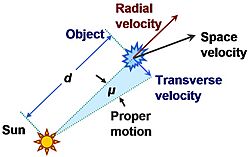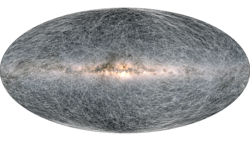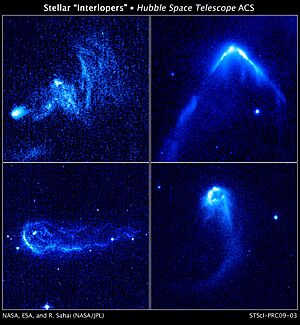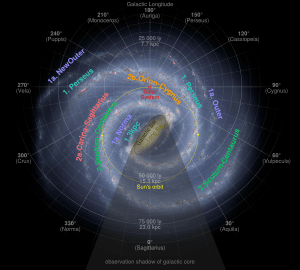Stellar kinematics facts for kids
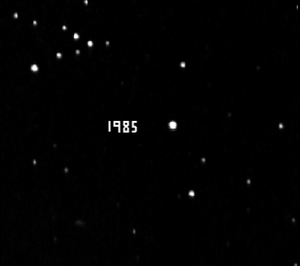
Stellar kinematics is the study of how stars move through space. By measuring the speed and direction of stars, astronomers can learn a lot about our galaxy, the Milky Way, and other galaxies far away.
Think of it like being a space detective. By tracking the movements of stars, we can figure out where they came from, how our galaxy was built, and even find amazing objects like supermassive black holes. Scientists study the motion of stars in all parts of the Milky Way, including its flat disk, its puffy center called the bulge, and its vast outer region known as the stellar halo.
These measurements can also help us spot very unusual stars, like hypervelocity stars. These are stars that are moving so fast they are escaping the Milky Way entirely! Scientists believe they were flung out after a close call with the supermassive black hole at the center of our galaxy.
Stellar kinematics is different from stellar dynamics, which uses math and physics to create models of how stars should move because of gravity. Astronomers compare the real movements they observe (kinematics) with these models (dynamics) to test their ideas and discover new things, like the existence of dark matter.
Contents
How We Measure a Star's Motion
To understand a star's true movement, astronomers need to measure it in a few different ways. The total movement of a star through space is called its space velocity.
A star's motion has two main parts:
- Radial Velocity: This is the star's movement either directly toward us or away from us. We can measure this by looking at the star's light. If a star is moving away, its light waves get stretched out and look redder (this is called redshift). If it's moving closer, its light waves get squished and look bluer (blueshift). This change in light is called the Doppler effect.
- Proper Motion: This is the star's movement from side to side across our sky. It's much harder to see because stars are so far away. Astronomers have to take pictures of a star over many years and carefully measure how its position changes compared to even more distant objects.
Once astronomers know the star's radial velocity, proper motion, and its distance from Earth (which they can find using methods like parallax), they can combine them to calculate the star's true space velocity.
Why Studying Star Movements is Important
Stellar kinematics gives us amazing clues about stars and the galaxies they live in. By combining measurements with computer models, we can learn about:
- The Rotation of the Milky Way: By measuring the motion of many stars in the Milky Way's disk, we've learned that our galaxy spins. Stars closer to the center orbit faster than stars farther out.
- The Structure of our Galaxy: Our Milky Way has different parts, and the stars in each part move in a special way.
-
- The disk is the flat part where our Sun is. Stars here move in mostly circular orbits, all going in the same direction, like cars on a racetrack.
- The bulge is the crowded ball of stars at the center. Stars here zoom around in all different directions.
- The halo is a huge, faint sphere of old stars surrounding the rest of the galaxy. These stars travel in long, stretched-out orbits that go high above and below the disk.
- Finding Supermassive Black Holes: In the very center of our galaxy and others, stars are moving incredibly fast. The only thing with enough gravity to make them move like that is a supermassive black hole.
- Evidence for Dark Matter: In the outer parts of galaxies, stars and star clusters are moving much faster than they should be, based on the gravity from all the visible matter. This tells us there must be a huge amount of invisible stuff called dark matter, whose gravity pulls on everything around it.
New Discoveries with the Gaia Spacecraft
In 2018, a space mission called Gaia gave astronomers a huge treasure chest of new data. Gaia is creating an incredibly precise 3D map of over a billion stars in our galaxy.
The Gaia data includes the most accurate measurements ever made of stars' positions, movements, and distances. This has helped us understand the Milky Way's structure better than ever before. With Gaia, scientists have been able to:
- Measure the exact motions of ancient star groups called globular clusters.
- Track nearby dwarf galaxies as they orbit the Milky Way.
- Find more hypervelocity stars and trace their paths back to where they came from.
- Learn about the history of our galaxy by seeing how groups of stars have merged with it over billions of years.
High-Speed Stars
Some stars move much faster than their neighbors. A star is considered a high-velocity star if it moves faster than 65 to 100 km/s relative to the stars around it. There are three main types.
Runaway Stars
A runaway star is a star that has been thrown out of its original home and is now speeding through space. If you trace its path backward, it often points directly away from a stellar association (a group of stars born together).
How does a star become a runaway?
- Gravitational Slingshot: Sometimes, in a system with three or more stars, a close gravitational encounter can fling one of the stars out at high speed.
- Supernova Kick: If a star is in a binary pair (two stars orbiting each other) and its partner explodes as a supernova, the explosion can "kick" the remaining star, sending it flying.
A famous example is the trio of runaway stars AE Aurigae, 53 Arietis, and Mu Columbae. They are all moving away from each other at over 100 km/s. Their paths all trace back to the Orion Nebula, where a supernova likely launched them on their way about 2 million years ago.
Halo Stars
Halo stars are very old stars that live in the galactic halo. Instead of orbiting in the flat disk like our Sun, they travel in long, elliptical orbits that take them far above and below the galactic plane. Even though their total speed might not be faster than disk stars, their strange paths cause them to have very high velocities relative to the Sun and other nearby stars. Kapteyn's Star is a nearby example of a halo star passing through our neighborhood.
Hypervelocity Stars
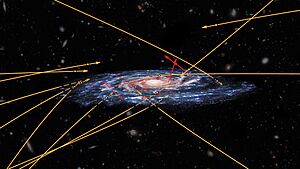
Hypervelocity stars (HVS) are the ultimate speed demons. They move so fast—sometimes over 1,000 km/s—that they can completely escape the Milky Way's gravity and fly off into intergalactic space.
Most of these stars are thought to come from the center of our galaxy. The most common theory is that a binary star system wandered too close to the supermassive black hole. The black hole's immense gravity captured one of the stars, forcing it into a tight orbit, while the other star was violently ejected, becoming a hypervelocity star.
In 2019, astronomers found an A-type star named S5-HVS1 traveling at an incredible 1,755 km/s (over 6.3 million km/h). It is one of the fastest stars ever discovered and was almost certainly ejected by the black hole at the center of our galaxy.
Star Families on the Move
A set of stars that have similar ages and travel together through space is known as a kinematic group. These stars were likely born from the same giant cloud of gas and dust. Even after the original star cluster breaks apart, the stars continue to travel as a loose family.
Stellar Associations
A stellar association is a very loose group of young stars that were born together and are still moving in the same general direction. They are no longer held together by gravity. There are a few types:
- OB associations contain very hot, massive, and bright blue stars (types O and B). These stars live fast and die young, so these associations are only a few million years old.
- T associations are filled with young, cooler stars called T Tauri stars, which are still in the process of becoming stable, sun-like stars.
- R associations are groups of stars that are lighting up the gas and dust clouds around them, creating beautiful reflection nebulae.
Moving Groups
When a stellar association gets older and its stars drift farther apart, it becomes a moving group. Astronomers can still tell these stars are related because they share the same age, chemical makeup, and motion through the galaxy.
The closest moving group to us is the Ursa Major Moving Group. It includes most of the stars in the Big Dipper asterism, except for the star at the end of the handle (Alkaid) and the star at the front of the bowl (Dubhe).
Stellar Streams
A stellar stream is a long, thin ribbon of stars orbiting a galaxy. These streams are what's left of a smaller dwarf galaxy or globular cluster that was torn apart by the Milky Way's powerful gravity. They are like a trail of breadcrumbs showing the path of the object that was destroyed.
The Sun's Journey Through the Galaxy
Our Sun is not sitting still. It, along with the entire Solar System, is orbiting the center of the Milky Way.
- The Sun travels at an average speed of about 230 km/s, or 828,000 km/h.
- It takes the Sun about 225 to 250 million years to complete one orbit around the galaxy. This huge amount of time is called a galactic year.
- The Sun's path is not a perfect circle. It also bobs up and down through the galaxy's disk, crossing the galactic plane about every 42 million years.
Since the Sun is about 4.6 billion years old, it has completed about 20 orbits around the Milky Way in its lifetime.
See also
- Astrometry
- Gaia (spacecraft)
- Hipparcos
- n-body problem
- Open cluster remnant
- List of nearby stellar associations and moving groups
- Stellar association


